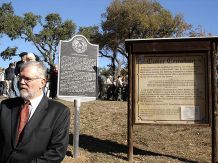South Carolina native John “Jack” Coker came to Texas in 1834 and ended up being part of Texas history when he fought in the Battle of San Jacinto, which decided the Republic of Texas' war for independence from Mexico.
The newly independent republic then thanked John Coker for his service by gifting him with 1,920 acres along the Salado Creek 10 miles north of downtown San Antonio.
John Coker wrote his brothers Joseph and James, asking their help in settling the land.
The Coker family grew, and that land developed into a community of sorts where the family name became synonymous with the evolution of San Antonio's North Side.
On Saturday, Coker family members gathered at Coker Cemetery, on the grounds of their namesake church and park between West Avenue and U.S. 281, to unveil and dedicate a Texas historical marker.
More than 100 family and friends, invited by the Coker Cemetery Association, attended the ceremony. The Texas Historical Commission (THC) marker officially signals the graveyard a historic Texas cemetery.
“How wonderful it was for all these forbearers, people of vision, to have helped save this place,” said former San Antonio Mayor Lila Cockrell.
Cockrell said she was amused in reading a history of the Coker land, referring to how at one time the property was leased to a rattlesnake hunter.
“Today, we are celebrating people who had a vision to keep this cemetery going,” Cockrell said, who then recited “In Flanders Fields,” a famous poem penned by a Canadian lieutenant colonel who served during World War I.
“This is a reminder to remember those who've gone before us and to honor their memories,” she added.
According to the association, a non-profit started in 1967 to properly maintain the cemetery, as the first Coker family settlement grew, tragedy struck in 1857.
That's when James Coker's 6-year-old son, Loucious, died from a rattlesnake bite and was buried on a high knoll near Salado Creek.
A large limestone headstone was placed at the site and remains the cemetery's most prominent memorial.
John Coker died in 1861 and buried on site. Twelve years later, Joseph Coker conveyed a 201-acre tract to his two sons, and conveyed a three-acre tract to trustees for use as a neighborhood church, school and cemetery.
Family members built a schoolhouse where a Methodist congregation set up shop in 1885.
Coker United Methodist Church eventually was established along with a day school. Neighborhood education continued also in the form of Coker Elementary School, which currently is located on Heimer Road, just across U.S. Hwy. 281 from the church and cemetery property.
Two Texas historical markers previously were located within the cemetery, marking the final resting sites of John Coker and of Jefferson Davis Smith, who was captured by Lipan and Comanche Indians as a boy.
“The nice thing about the designation is that, once it's called historical, it's to be preserved. You can't just run a highway right through here or anything like that,” said association President C.A. “Butch” Gerfers.
“Historical markers are important for future generations to have and remember the history. It serves to say this place is important, that there's a message,” Cockrell said.
Gerfers said Coker Cemetery holds 300 burial plots. Existing headstones bear family names familiar with the settlement of north central and northeast San Antonio: Jones, Maltsberger, Isom, Sandau, Gordon and Voelcker.
“This cemetery is a Texas history lesson,” said Marion resident Tom DeKunder, grandson of Fannie May Coker.
“It took us two years do accomplish this. It's hard getting a historical marker. I consider this a dedication to the Coker family.”
Coker explained the process of landing a historical cemetery marker from the state is long and arduous, adding that someone must first apply for designation and then apply for the marker.
A cemetery's age is just one of several factors the THC takes into consideration.
Of the 50,000 historic cemeteries in Texas, current records have the precise location of only a fraction of these graveyards.
For more information, visit www.cokercemetery.com.


 Comments
(
Comments
(
 Printable
Version
Printable
Version Email
This
Email
This Font
Font
.gif) Printable Version
Printable Version
